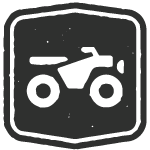
Snow Mobiling


Minimize your impact by traveling only in areas open to snow mobiles. Learn more about our RIDE ON campaign.
TRAVEL RESPONSIBLY
Travel responsibly on designated roads, trails and areas.
- Travel only in areas open to your particular tracked snow mobile
- Comply with signs and respect barriers.
- Avoid trails with inadequate snow cover.
- Avoid riding in potential avalanche areas. Periodically check for clues to an unstable snowpack. Use terrain to your advantage, avoiding steep slopes, cornices and gullies or depressions.
- One rider at a time on slopes.
- When climbing a hill, approach the summit with caution.
- Do not ride off cornices.
- Avoid riding on frozen waterways and lakes.
- Be aware of unmarked hazards or obstacles hidden beneath the snow.
- Travel at reasonable speeds.
- When approaching a corner, reduce your speed to avoid sliding.
- Pump your brake when going downhill to avoid locking the brakes.
- Cross roadways at a 90-degree angle.
- When riding at night, use extra caution, wear reflective clothing and reduce your speed.
- Observe the person capacity/ weight limit for your particular machine.
- Buddy up with two or three riders, reducing your vulnerability if you have an accident or breakdown.
- Listening to headphones or ear-buds can make it difficult to hear and communicate with other recreationists. In some areas it is illegal to operate snow mobiles with both ears covered.
- Don’t mix riding with alcohol or drugs.
RESPECT THE RIGHTS OF OTHERS
Respect the rights of others, including private property owners, all recreational users and campers so they can enjoy their recreational activities.
- Be considerate of others on the trail.
- Keep speeds low around crowds and staging areas.
- Ride single file, keep to the right and pass on the left only when the trail is clear.
- When stopping on the trail, pull your snow mobile as far right and off the trail as possible.
- Yield the right-of-way to skiers, snowshoers and other non-mechanized forms of travel, as well as those passing or traveling uphill.
- Use common trail hand signals to communicate with your group and other riders.
· If crossing private property, be sure to ask permission from the landowner(s).
EDUCATE YOURSELF
Educate yourself prior to a trip by planning ahead, obtaining travel maps and regulations from public agencies, taking recreation skills classes and knowing how to operate your equipment safely.
- Obtain a motor vehicle use map, and over snow vehicle use map of your destination, if available, and determine which areas are open to snow mobiles.
- Contact the land manager for area restrictions, closures and permit requirements.
- Take a snow mobile safety course.
- Take an avalanche class. They provide skills on assessing snow conditions, performing rescues and using safety equipment.
- Always check the weather forecast and avalanche conditions in advance and the day of.
- Make a realistic plan and stick to it. Always tell someone of your travel plans. If conditions change, be prepared to alter plans to ensure safety.
- Understand how to operate your vehicle and its controls.
- Wear an avalanche transceiver, shovel and probe on your body at all times.
- Prepare for the unexpected by packing a small backpack full of emergency items.
- Wear a helmet, eye protection and other safety gear.
- Layer clothing and wear a durable waterproof outer shell and footwear.
- Make sure your snow mobile is mechanically up to the task.
- Be prepared with tools, supplies and a spill kit for trailside repairs.
- If you suffer a breakdown, stay with your snow mobile and stay on the trail.
- If a person develops hypothermia, warm the person up by rubbing them vigorously and getting them into dry clothes. Give them warm non-alcoholic liquids.
AVOID SENSITIVE AREAS
Avoid sensitive areas such as meadows, lakeshores, wetlands and streams. Stay on designated routes.
- Motorized and mechanized forms of travel are not allowed in designated Wilderness Areas.
- Low snow, don’t go. A snow mobile’s spinning track(s) damage plants and soils just below the snow’s surface. Hill climbing in these conditions is especially damaging.
- Do not disturb historical, archeological or paleontological sites.
- Be respectful of wildlife’s wintering habitats.
- Avoid “spooking” livestock and wildlife and keep your distance.
DO YOUR PART
Do your part by modeling responsible behavior, leaving the area better than you found it, properly disposing of waste, minimizing the use of fire, avoiding the spread of invasive species, and restoring degraded areas.
- Carry a trash bag on your snow mobile and pick up litter left by others.
- Pack out what you pack in. Dispose of all sanitary waste properly by packing it out or bury it 6 to 8 inches deep in soil.
- To minimize harmful emissions, keep your engine in tune.
- Prevent unnecessary noise created by a poorly tuned vehicle or revving your engine. Use proper silencers on exhausts, which meet regulatory decibel levels.
- Build a trail community. Get to know other types of recreationists that share your favorite trail.















